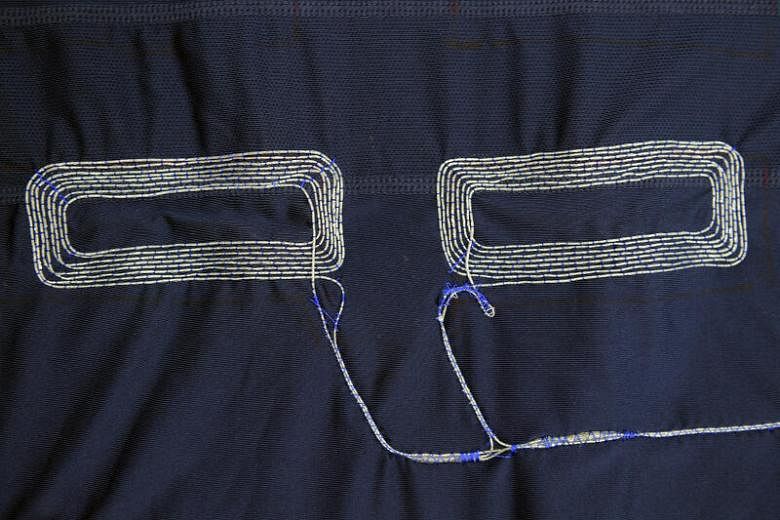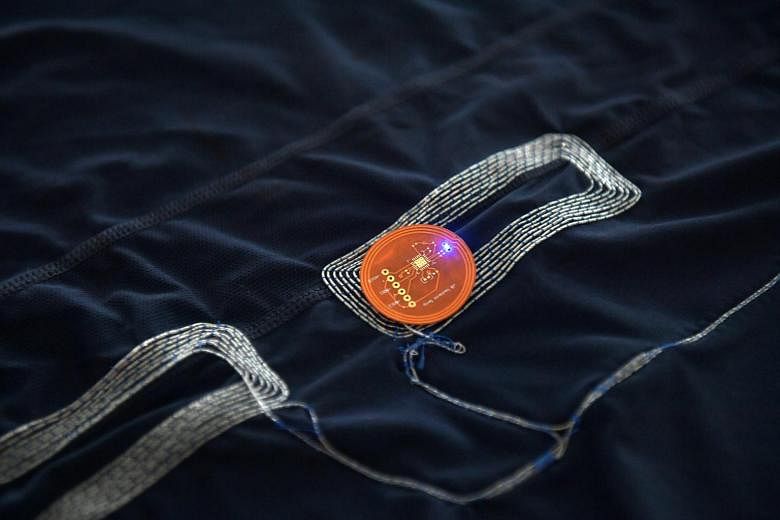SINGAPORE - Researchers from the National University of Singapore (NUS) have developed a smartphone-powered suit which can track one's temperature, posture and movements at the same time.
Bearing a close resemblance to Spider-Man's costume, the suit's design consists of a recurring pattern of web-like threads, which are key in connecting the smartphone to sensor chips placed around the body.
Sewn with conductive silver threads, the patterns act as hubs relaying the smartphone's near-field communication signal to the selected locations around the body.
Assistant Professor John Ho, who led the team of researchers from the NUS Institute for Health Innovation and Technology, said: "Our smart suit works with most modern smartphones, which act as both the source of power as well as the display to view the sensor data. The creation of a smart suit which can be powered using built-in smartphone wireless technology is a major breakthrough."
Their research findings were published in the scientific journal Nature Communications in January.
To better understand and experience the novelty of this technology, I decided to try on the smart suit.
The complete prototype suit comprises of three separate pieces - a jumper, a dry-fit T-shirt and a pair of tights - all of which are able to support up to six sensors at the same time.
I start with the jumper.
Orange-colored sensor chips are then stuck to circular hubs located around the suit.
To activate the sensors, the smartphone has to be carefully aligned to its epicentre, which is the largest hub located prominently across the chest area.
Done.

The phone buzzes, and the LED lights on the sensors turn blue, indicating that the connection is successful.
First things first, I check my temperature by gently pressing the sensor node with my index finger.
I observe the graph on the phone app as the sensor adjusts to my body temperature. It climbs steadily and eventually peaks at 34 deg C.
That's because our body temperature, when taken from the fingers, tends to be a little lower than usual.
Next, I try out the running gait function, which tracks my movements over time and detects any signs of fatigue.
To activate these sensors, the smartphone is placed in a pocket behind my right thigh, where the hub is located, and the sensors on my tights light up.
To mimic running movements, I bend my knee repeatedly, and the data is recorded on the app.
Prof Ho explained that the sensors are able to continuously record data during the span of a run, and detect any variability in one's running stance.
High variability would therefore indicate possible fatigue and over-exertion.
Finally, I look at my spinal posture. To do so, I change into the dry-fit tee, which has a small pocket on its right sleeve, where the phone is placed .
A sensor chip is stuck onto the back of my neck for easy demonstration.
Done, activated.
As I bend my neck repeatedly, the app continuously tracks and records my movements.
Ideally, the suit should be used to monitor one's posture over the course of a day, with sensors placed along the spine to detect how frequently the back bends, giving an indication of posture.
This can help clinicians better understand patients who face chronic back pain, and, in turn, provide insights for diagnosis and treatment, said Prof Ho.
The team is currently looking to improve its app interface so that all sensor data can be displayed at the same time for easy tracking.
In addition, the researchers plan to develop new sensors to increase the range of data collection, including for sweat detection, which indicates possible dehydration, and blood oxygen levels to detect early signs of respiratory distress.




